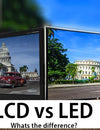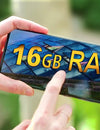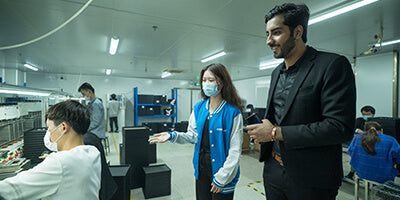
LCD screens are widely used in various electronic devices. Due to the greatly reduced cost, LCD screens have gradually become the most popular screens on the market. The size of the screen is greatly reduced, making notebooks, pads, and mobile phones more portable in daily life.

1.LCD screen structure
LCD is the abbreviation of liquid crystal display, and now the mainstream is TFT-LCD (thin film transistor-liquid crystal display) technology. The LCD screen includes a backlight source and a polarizer. The most important thing is to place liquid crystal in two parallel glass substrates, place a TFT thin film transistor on the lower substrate, and place a CF color filter on the upper substrate (with RGB red, green and blue light) .

2.Color principle
Because there are three color blocks of RGB printed on the CF color filter, the color image we see can be displayed when the light from the backlight source of the screen passes through the color filter.The light first passes through the transparent TFT thin film transistor substrate, and then passes through the liquid crystal molecules, and then passes through the CF color filter, affected by the different transmittance of the liquid crystal molecules under each color block, the color blocks will emit red, green and blue colors with different brightness and darkness, thus mixing into a Display of the desired color. Each of these color blocks are tiny enough to form a colorful image, which is what we call pixels!

3.What is LCD?
Liquid crystals are a special state of matter. The so-called state of matter, we know the most are gaseous state (water vapor), liquid state (water droplets), solid state (ice cube), and another one that we always hear about is plasma state (fire). This time, let’s get familiar with the state of liquid crystals. It has various characteristics of solid crystals and the fluidity of liquids. Liquid crystal molecules exhibit different optical characteristics under different voltages. Like metal in a magnetic field, liquid crystal molecules will have a certain directionality when affected by an external electric field. Therefore, as long as we properly control the alignment of liquid crystal molecules, we can control the liquid crystal molecules to allow some light to pass through, and some not to pass through, which results in a difference in light transmittance.

4.The magical effect of polarizer
Let's look at the two polarizers of the LCD screen. Their directions are perpendicular to each other, and generally speaking, they cannot pass through the light. However, the liquid crystal molecules are arranged to form a helix, which rotates the light so that it can pass through the second layer of polarizer and appear in front of the screen.

5.The production of liquid crystal
Let's take a look at the manufacture of liquid crystal which has caused earth-shaking changes in electronic equipment for half a century. LCD screen manufacturers need to purchase liquid crystal raw materials. Workers pour chemical raw materials into tanks. After a series of reactions, they will finally get liquid substances. Then the liquid crystal solution is sent to be purified, and then poured out for drying. After the liquid crystal solution slowly crystallizes, white crystals will form, and different liquid crystals will show different states. Finally, they are crushed into powder, and the liquid crystal used in the LCD screen is made by mixing many of these monomers.

6.Photolithography
It is not enough to have liquid crystal as the main material. In addition to passing light, it is also necessary to control the "brightness" and "chromaticity" of light. The production lines of LCD are as follows: first ARRAY manufacturing, then CELL panel manufacturing, and finally MODULE assembly.In the ARRAY factory, the core part of the TFT thin film transistor substrate is the photolithography process. The so-called "photolithography" is to use light as a knife to engrave the photosensitive protective layer. This photosensitive material is photoresist.

7.Array Manufacturing
The TFT thin film transistor can be regarded as the production of circuit boards. When making it, first cover the patterned light cover on the photoresist material and irradiate it with ultraviolet light, then the light exposed part will undergo photo curing reaction and dissolve in photoresist development to obtain the image we need. After developing and heating again, the film layer not protected by the photoresist can be etched, and then the film is peeled off, and the photoresist removal solution can be dropped, which can keep the part protected by the photoresist, and complete a thin film transistor manufacturing. Repeating the steps of film deposition, photoresist coating, exposure, and development many times, the photolithography of TFT thin film transistors is completed.


8.Panel Production
We need to clean the substrate first. First, evenly coat the alignment liquid on the cylinder, and then transfer it to the glass substrate. After heating and curing, the alignment film is formed.Then use the grooved alignment rubbing cloth to roll out the grooves on the alignment film, so that the liquid crystals are arranged regularly on the substrate, forming a certain pre-tilt angle. If there is no alignment film, the liquid crystals will be scattered on the substrate, and we will not be able to control the direction of light. For CF color filters, we do the same alignment.Next, spacers are sprayed to control the thickness of the liquid crystal layer and support the space between the two substrates. Finally, in a vacuum environment, the liquid crystal is dropped, and the TFT and CF are aligned and pressed to make the mother board of the liquid crystal panel. Then use ultraviolet light irradiation and heating process to harden the frame glue. Finally, it is cut and pasted to make a liquid crystal panel.

9.Module assembly
Last step! Assemble the LCD panel, backlight and other components into a module, and then test them together before leaving the factory. The LCD liquid crystal finished panel (Cell), anisotropic conductive adhesive (ACF), driver IC, flexible circuit board (FPC) and PCB circuit board are pressed together by the machine. Next, it is necessary to assemble the finished product together with the backlight panel, light source, and iron frame. The last is the burn-in test and quality inspection. After there is no problem, the production of an LCD screen is completed.


About Oriwhiz
ORIWHIZ is a mobile phone LCD/OLED screen and other phone spare parts' manufacturer(factory),we offer OEM and ODM service to customers all over the world.Our products have ISO9001,CE,FCC,ROSH certificate.All of our products are manufactured by brand new materials and 100% quality test before shipping.We promise our best quality products will be delivered to our clients on time.We have professional customer service and welcome inquiry any time. Our main products include: iPhone LCD,iPhone Charging Port,iPhone Front Camera,iPhone Back Camera,iPhone ear speaker,iPhone Battery.etc.Not only iPhone related products,we also have mobile phone parts for Samsung,Huawei,Xiaomi Oppo,Vivo etc.























